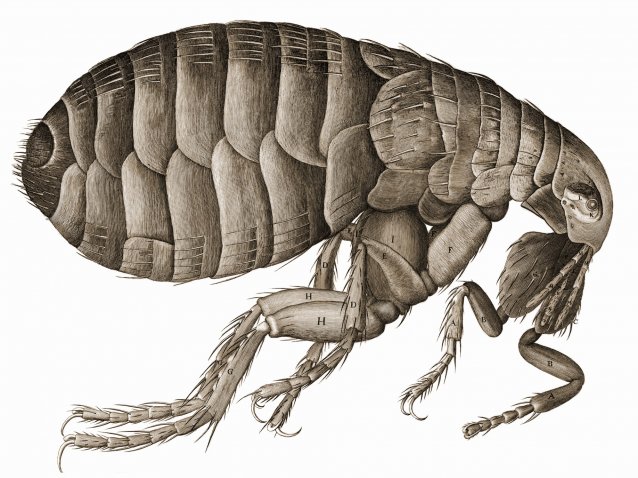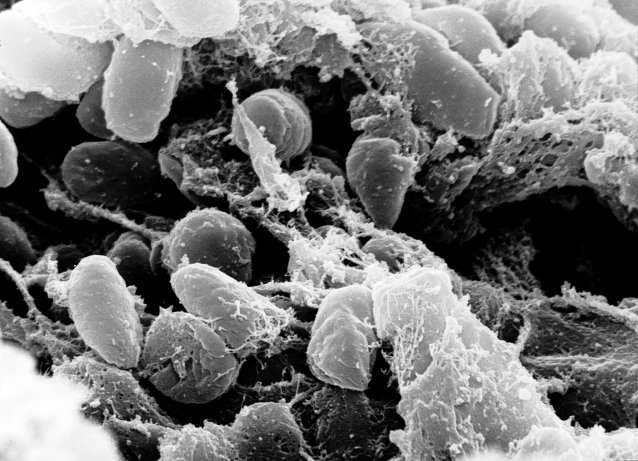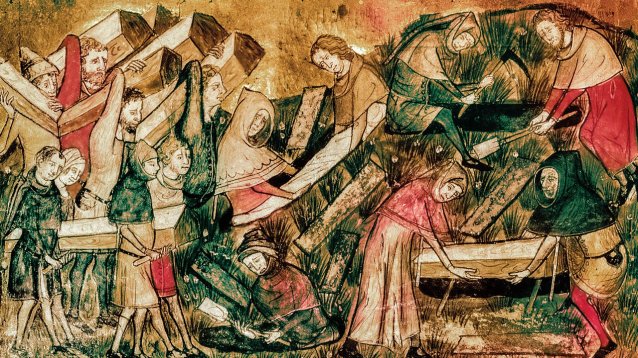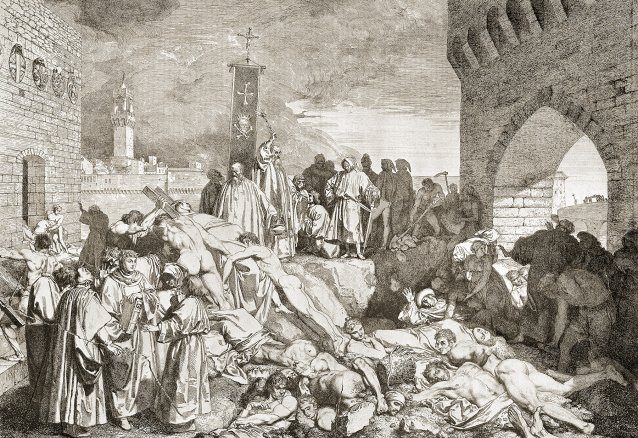I wrote the following piece while I was teaching alongside Keith Wrightson in the Yale-in-London program during the summer of 2007, and it was the first of my review articles to be accepted by the late Holly Eley for publication in The Times Literary Supplement. They even gave me the cover illustration: a large, lurid flea. It was also the very first piece I wrote following a sobering, indeed unforgettable medical emergency that took place early on one bright frigid morning the previous February. It seems perfectly obvious now why the subject so intrigued me, but I am not sure it was so clear at the time. Nothing at all was.

The Triumph of Death, c. 1562 by Pieter Bruegel the Elder
The Black Death
by Angus Trumble, 30 August 2018
The best horror stories are real. A flea sinks its proboscis into the skin of a sick black rat, feeds on its blood, and ingests lethally multiplying bacteria. In the confined space of its tiny alimentary canal, the bacteria multiply to such an extent that they form a blockage in the stomach of the flea. In desperation, after it senses a drop in the body temperature of the rat, which is by now dead, the increasingly ravenous flea jumps ship. It cannot find another living rat in the nest. Rat nests having for millennia thriven in barns and granaries, the flea does not have to travel very far to find an alternative source of food. It searches out the nearest man, woman or child, maybe burrows its way through layers of clothing, and sinks its proboscis into warm flesh.
The blockage in its stomach prevents the maddened, dying flea from being able to ingest more than a small amount of human blood, and causes it instead to regurgitate tiny amounts of infected rat blood that, breaking free from the blockage, carry thousands of bacteria into the open wound. So gaining entry to the largely defenceless human body, the bacteria travel through the lymphatic system to nodes in the groin or under the arms or in the neck, congregate, multiply hugely, create a bubo of exquisite, agonizing sensitivity, which duly propels bacteria into the blood stream, and in 80 per cent of cases overwhelms, then kills the sufferer. In rare instances when the flea vomits directly into a tiny blood vessel, the bacteria by-pass the lymphatic system entirely, further multiplying at a dizzying rate, bringing death in a matter of hours, with 100 per cent mortality. Thus, in a vignette that has been played out by thousands of generations of fleas, Yersinia pestis, the seemingly unstoppable bacterium we know and fear as the bubonic plague, plays leap-frog from rat to person, and runs its ghastly course.
The plague has been endemic for thousands of years, and makes its earliest recorded appearance in the first book of Samuel. Serious epidemics have occurred regularly, most recently in 1993 in Surat in India. However, in the mid-fourteenth century, in a textbook illustration of the processes of natural selection in both black rats and the handful of fleas that live in their fur and feed on their blood—because rats have so completely adapted themselves to human society, and the fittest of their fleas have in turn gradually acquired the ability to survive on dry grain when no rat blood is available—the disease evidently surfaced, suddenly ignited, and turned into a colossal pandemic. This in turn caused an unprecedented, terrifying human catastrophe throughout Western Asia, Asia Minor, the Middle East, the Arab world, North Africa and the whole of Europe from Gibraltar to Bergen and from the Faroes to Moscow. It is remembered as the Black Death. In many places it is now estimated that 60 to 70 per cent of the entire population perished. Nothing like it had ever been experienced before, and nothing as destructive has happened since. Compared with this volcanic eruption, the Spanish Flu pandemic of 1918−19 counts as a serious earth tremor, certainly, but, in terms of the rate of mortality, not more. How and why did the plague, which is still among us, turn into the Black Death? Was the Black Death, in fact, the plague? Could something like it happen again?
Possibly not. The Black Death occurred when agrarian, largely feudal, grain-dependent, rat-nourishing societies had created a sufficiently elaborate infrastructure for trade and communications that for the first time made possible the kind of catastrophic, so-called metastatic leaps from country to country and region to region that were previously nearly impossible for Yersinia pestis to achieve. Those leaps offered for the first time a window of opportunity for a fierce flea-borne pandemic, unrestrained except by its own mind-boggling virulence. And despite its catastrophic impact, wiping out the generation of Ambrogio Lorenzetti, the Black Death appears to have given the economy of Europe the jolt that brought it kicking, if not screaming, into the early modern era. The Renaissance occurred soon afterwards. Scientific discoveries proliferated; punch-drunk, nearly empty universities responded to the crisis by building new colleges. Cities flourished. The world as we know it began to take shape. Was it therefore in some shocking developmental sense actually “necessary”?
Ole Benedictow’s remarkable, engrossing and controversial study is the first, as its subtitle claims, to assemble and synthesize historical data from every region in which the Black Death wrought havoc from 1346 to 1353. Together with up-to-date, entomological, demographic, bacteriological and epidemiological research, Benedictow has pieced together an accurate picture of exactly whence, where, when and how the Black Death spread—month by month, day by day, down to the movement of particular rat-infested ships, and the astoundingly rapid progress of the disease in hair, bags, clothing, books and sacks of grain, by foot and on horseback, by cart and dray, along particular roads, footpaths, and rivers and waterways all over Europe. The Black Death, 1346−1353 is an immense and entirely breathtaking feat of scholarship, the work of many patient years, and a moving quest to account for a cruel phenomenon that defies description.
Based on an awe-inspiring range of data, at once fugitive and revealing, the book displays a knowledge of many late-medieval languages, and a mastery of the plague and Black Death literature, which is depressingly incoherent in tracing the entire pandemic, even though it is strong on mapping the disease in certain localities such as England and Scandinavia; the coverage is weaker for Switzerland and Poland; and for Romania, Moldova and Belarus it is almost non-existent. Above all, Benedictow manages to keep an eye on a few large questions, and to avoid the serious risk of drowning in a sea of laws, commodity prices, rents, tenancies, and other agricultural matters, notarized transactions and official documents of every description.
From these sources logical conclusions may be drawn about the behaviour of rats and fleas, the calamitous agency of their oblivious human travelling companions, and the fatal consequences for hundreds of thousands of people of relatively unimpeded social interaction, trade, and travel by land and sea. At different times the author has had to read between the trope-laden lines of the chroniclers, who rarely if ever mentioned the Black Death until their community was so nearly obliterated by it that not to record the facts must have seemed plainly bizarre, even to persons who adhered to the strictest standards of decorum and scholastic rhetoric. Sickness and contagion killed trade, so prudent officials usually suppressed news of the Black Death until there was no point, or nobody left to buy anything, or zero production, or no harvest, and nothing to sell.
Among the most moving sources are the jottings of scribes and notaries who knew they were doomed and concluded their life’s work with a note to that effect, and a prayer. Brother John of Kilkenny even added a few more pages to a ledger but doubted, he wrote, if it would ever be used, or even needed. He was right. The last sentence, written by a copyist, reads Videtur quod Author hic obit (evidently the author died here). Another writer wondered if anyone at all would be spared and, in the unlikely event that they were, whether future generations would find it possible to believe what had happened. As the sickness arrived and the deaths piled up, there was a rush on notaries to register wills – an intriguing reminder that in earlier times people only made their will when they knew they were dying. The rate of appointments to benefices trebled, quadrupled, increased by a factor of ten, and then broke down, utterly unable to cope with the rate at which priests performing the last rites could be replaced, as they too dropped like flies. Upon the distress of the sickness was heaped the further agony of dying without receiving the sacrament of extreme unction. Rents halved, then halved again. Whole communities vanished. Land tilled for centuries lay fallow, then turned into forest. The cost of labour rose tremendously: workmen could name their price, those few who survived. Specialist skills flourished. Armies of brawny labourers took a century and a half to regenerate; building projects had to be scaled down, rethought, abandoned. Princes were besieged with requests for grants of land for new cemeteries; gravediggers dug graves for all their children, their parents, their wives, and then one for themselves – but by then there was nobody left to lay them in it. Very often the sources conclude with the haunting ellipsis that tells you that the writer simply….
Two aspects of the Black Death are to me entirely revelatory. First, scholars at the time so nearly achieved an understanding of what was going on, but didn’t quite. Extravagant prophylactic religious measures were widespread, mostly a rash of church and shrine building that has long been noted—the Orcagna effect: a sudden, and entirely reasonable embrace of the formal, the hieratic, the penitent, the apocalyptic (look busy, the end is nigh)—but on the whole, educated people clearly understood that the disaster was medical, and the disease fearfully contagious. Yet not an iota of suspicion was directed towards something as commonplace as the black rat. Instead the miasmatic or bad-air theory of infection proved unshakeable. A Spanish bishop was told to stay in his palace, sweltering near a roaring fire, and not let anybody in; naturally sick rats and dying fleas came and went unimpeded. The really remarkable thing is that the bad-air theory was partly correct, inasmuch as what I didn’t mention at the start is that once the rat-to-flea-to-person process of contagion is accomplished, a further devastating human to human step follows, when, as if to amplify the horror, as a consequence of the illness, the sufferer begins to cough up droplets of blood from infected lungs which, airborne, carry plague bacteria into clean lungs and convey the illness into the body of new victims by that route. This is called pneumonic plague and, late, in seventeenth-century England, gave rise to the old nursery rhyme “Ring-a-ring-o’-roses”. (The pocket full of posies was prophylactic, but obviously not effective.)
Second, rural communities suffered a consistently higher rate of mortality than the towns, because the attack rate of fleas and of human to human pneumonic plague transmission proved more effective in small clusters of people than in higher densities. So a higher proportion of people in single households were bitten by fleas swarming from each infested nest. From this fact those of us who now live in gigantic cities should take some comfort. And in the mid-fourteenth century the bulk of the population of Europe was spread across the countryside in villages, not concentrated into large towns, where people quickly grasped the need to avoid houses that were overtaken by sickness. Priests administering the last rites in fact became the agents of contagion, while armies of refugees, clinging to the seductive notion of dirty city versus wholesome country, headed for the hills, but merely brought the disease with them in their clothes or luggage or bushels of grain or on their dog, or else increased by several times the likelihood of being bitten by a ravenous, infected flea in the very spot where they prayed they would find sanctuary.
The pandemic began as an epidemic of the bubonic plague in an army of Mongol-led tartars who in 1346 laid siege to a Genoese trading fortress at Kaffa in the Crimea. The heathen army gradually fell ill, panicked, scattered, and perished, but the Genoese (who resisted the siege, but contracted the disease) fled by ship across the Black Sea, and through 1347 deposited ship’s rats, mortally sick sailors and dead bodies in Constantinople and at trading posts far beyond, right around the Mediterranean, in Cyprus, Crete, Sicily, Genoa and Mallorca. Stealthily assisted by the delay in transmission, incubation and spread, the Black Death fanned out from each place, leaping onward, opening up two, three, and sometimes even four prongs of attack (as in Spain). Pilgrims carried it on foot back across the Pyrenees from Santiago de Compostella into southern France. It mowed across Italy, the Balkans, the south of France, the north of Spain and North Africa, and the south of England (1348). (Two ships brought it there from Bordeaux, one of which continued to Dublin.) The rest of France, Spain, England, Ireland, Switzerland, southern Germany, Bohemia and Norway toppled (1349), and then the remainder of Europe – Scotland, the rest of Germany, Denmark and Sweden (1350). Slowing down during the winter months, the pandemic nevertheless wept eastwards across vast territories in Poland, Russia and Ukraine (1351-3). By then it had arrived back at its starting point, the Golden Horde, the region stretching between the northern shores of the Caspian Sea and the Crimea. Only Finland, with next to no population at this date, and Iceland were spared—evidently not a single ship sailed there during the pandemic.
This picture of the Black Death is far worse that has ever before been acknowledged. Ever since the years between 1905 and 1914, when British doctors and scientists on the Indian Plague Research Commission gradually got to the bottom of the disease, the epidemiology of the plague has been wholly understood. Projection forward and backward from documented clusters of death, signs of panic, or highly suggestive movements of people or goods, or priestly visitations of large numbers of the sick and dying, should in theory enable the historian to arrive at reliable estimates of the movement, pace and route taken by infected people, rats and fleas, to calculate their acceleration, and to detect the sinister pincer movements that in so many parts of Europe brought the Black Death from several different directions at once.
In theory: the snag is that in several respects the plague epidemic of 1896, upon which the findings of the Indian Plague Research Commission were based, differed markedly from the Black Death in its rate of spread, and the fascinating question has been raised by Samuel K. Cohn, Jr., among others, who obviously now dispute many traditional assumptions about the disease and most of Benedictow’s conclusions, whether in fact the Black Death was the plague at all, and not some ghastly and now vanished or dormant microbial pandemic. They point to inconsistencies in the medieval documents as to the precise symptoms of the disease, the exact nature of the buboes, for example, which seem sometimes to be observed and recorded on the neck or under the ear and not in the armpit or the groin where they belong. They also point to the vastly different rates of morbidity and mortality (scarcely nudging 1 per cent of the population in India during the worst years). There is even a sub-controversy relating to which species of rat is the real culprit, and whether Rattus rattus, the black rat, and its fleas have been falsely accused.
These questions are almost impossible to resolve adequately using the existing fourteenth-century documents, and without any surviving genetic material – rat or human. However, I should have thought that among the factors to be taken into account are the facts that for obvious reasons groins did not exist in fourteenth-century catholic Europe; that her population had never before been exposed to plague bacteria, and that the rate of spread could presumably differ radically, dramatically, from that of the plague epidemics of late nineteenth-century China and South Asia, whose populations had by then accumulated waves of exposure to the disease and a concomitant genetic recollection of it, possibly extending back over millennia, in other words plenty of antibodies and a fighting chance. Whether or not we may therefore let black rats and fleas off the hook, and Cohn argues formidably on the basis of reasonable doubt that we should, it seems to me that the Black Death was sufficiently plague-like to permit the calculations and logical estimations of time from which Benedictow draws his intricate map of the disease. Faced with his case for the prosecution, in the long run I doubt if rats and fleas will be acquitted, or win any subsequent appeals.
Since bacteria are in some senses the lumbering mastodons of the microscopic zoo, comparatively easy to outsmart, it is tempting to argue that we are unlikely ever again to face anything bacterial as wholly appalling and destructive as the Black Death, assuming it was the plague. But medical science knows no convenient way of ridding the body of viruses, without taking out invaded cells as well—hardly a cure. True, some viruses can be eradicated by certain antiviral agents, and by the immune system. In the case of the more devious brands of virus, however, we can merely do our best to impede their reproduction, make life exceedingly difficult, control them with varying degrees of effectiveness, and at considerable cost. Any microbial organism that can emulate the Black Death by exploiting the speed and complexity of human interaction today—by learning to ride on the rubbish we put in our mouths, on the grubby hands that we shake and the sweaty cheeks we rub, by taking advantage of the fact that in big cities the air expelled from one lung so often straightaway enters another, not to mention the awesome density of the world’s current population, which makes fourteenth-century Europe look like less populous regions of Alaska—may yet catch us fearfully and suddenly by surprise.
There are grounds for optimism, because a decent proportion of us are cleaner, healthier, stronger, better nourished, better medicated, and more closely scrutinized than ever before, and our scientists see the risk. All of us are aware of germs; basic measures such as vaccination and quarantine are wholly standard; in fact the latter term originated as a measure to combat the plague. Flight routes are being studied, the behaviour of relatively benign organisms in respect of vast population densities watched closely. Little frights such as SARS—which took up quite a lot of column inches a few years ago—perform the valuable function of stimulating further research and awareness of the potential for disaster. But will this be enough to prevent a new catastrophe? How many of us truly recognize the heart-sinking significance of a plain yellow flag fluttering from the stern of a lonely vessel lying at anchor somewhere quite a long way off—not an uncommon sight until fifty years ago? It does not bear thinking about but Ole J. Benedictow and his critics are making it possible for us to do that with precision.
Ole J. Benedictow, The Black Death, 1346−1353: The Complete History.
Related information



The Gallery
Visit us, learn with us, support us or work with us! Here’s a range of information about planning your visit, our history and more!



Support your Portrait Gallery
We depend on your support to keep creating our programs, exhibitions, publications and building the amazing portrait collection!



Plan your visit
Information on location, accessibility and amenities.











